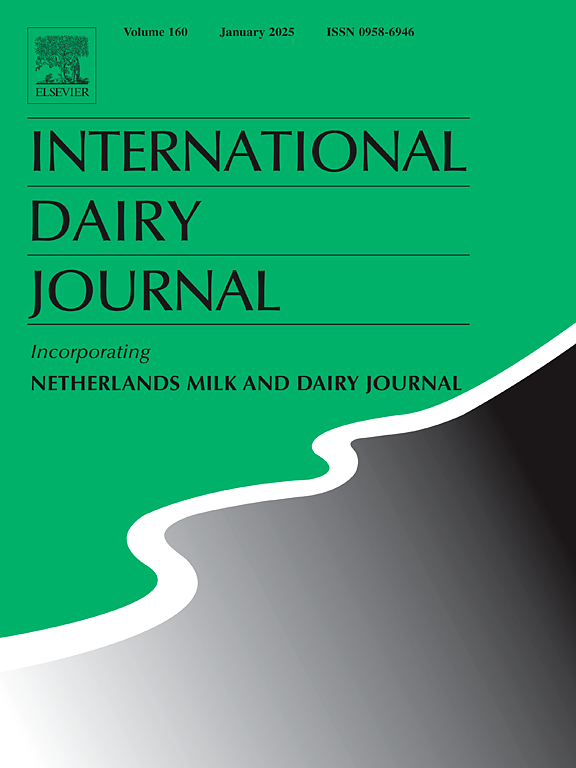用功率超声与均质法比较不同培养酸奶的脂肪酸谱、流变学和微生物学特性
IF 3.4
3区 农林科学
Q2 FOOD SCIENCE & TECHNOLOGY
引用次数: 0
摘要
超声波被认为是一种绿色技术,在乳制品行业具有巨大的潜力。与传统的均质化相比,它具有关键的优势,并且越来越重要,特别是对于发酵牛奶技术。因此,本研究探讨了该技术如何影响用产生或不产生eps的发酵剂生产的酸奶的流变学、微生物学和脂肪酸谱。超声波通常增加了两种培养物生产的酸奶中嗜热链球菌的活力,而只使用不产生eps的发酵剂生产的酸奶中保加利亚乳杆菌的活力。超声波还可以使不产生eps的培养物生产的酸奶粘度提高35%,稠度提高50%,并在两种培养物生产的样品储存结束时提高保水能力。超声降低了储存末期的致动脉粥样硬化和血栓形成指数以及饱和脂肪酸,而在储存中期和后期用两种培养物制造的酸奶中,超声增加了多不饱和脂肪酸。本文章由计算机程序翻译,如有差异,请以英文原文为准。
Fatty acid profile and rheological and microbiological characteristics of yogurts produced by different cultures using power ultrasound compared to homogenization
Ultrasound, considered a green technology, holds great potential in the dairy industry. It has key benefits over conventional homogenization and is increasingly important, particularly for fermented milk technology. Thus, this study investigated how this technology affects the rheology, microbiology and fatty acid profile of yogurts produced with EPS-producing or non-EPS-producing starter cultures. Ultrasound generally increased S. thermophilus viability in yogurt produced with both cultures, while it increased L. bulgaricus in yogurt produced with only non-EPS-producing starter culture. Ultrasound also increased viscosity by up to 35 % and consistency by up to 50 % in yogurt produced with non-EPS-producing culture, and increased water-holding capacity at the end of storage in samples produced with both cultures. Ultrasound reduced the atherogenic and thrombogenic indexes and saturated fatty acids at the end of storage, whereas it increased polyunsaturated fatty acids in yogurt manufactured with both cultures at the middle and end of storage.
求助全文
通过发布文献求助,成功后即可免费获取论文全文。
去求助
来源期刊

International Dairy Journal
工程技术-食品科技
CiteScore
6.50
自引率
9.70%
发文量
200
审稿时长
49 days
期刊介绍:
The International Dairy Journal publishes significant advancements in dairy science and technology in the form of research articles and critical reviews that are of relevance to the broader international dairy community. Within this scope, research on the science and technology of milk and dairy products and the nutritional and health aspects of dairy foods are included; the journal pays particular attention to applied research and its interface with the dairy industry.
The journal''s coverage includes the following, where directly applicable to dairy science and technology:
• Chemistry and physico-chemical properties of milk constituents
• Microbiology, food safety, enzymology, biotechnology
• Processing and engineering
• Emulsion science, food structure, and texture
• Raw material quality and effect on relevant products
• Flavour and off-flavour development
• Technological functionality and applications of dairy ingredients
• Sensory and consumer sciences
• Nutrition and substantiation of human health implications of milk components or dairy products
International Dairy Journal does not publish papers related to milk production, animal health and other aspects of on-farm milk production unless there is a clear relationship to dairy technology, human health or final product quality.
 求助内容:
求助内容: 应助结果提醒方式:
应助结果提醒方式:


